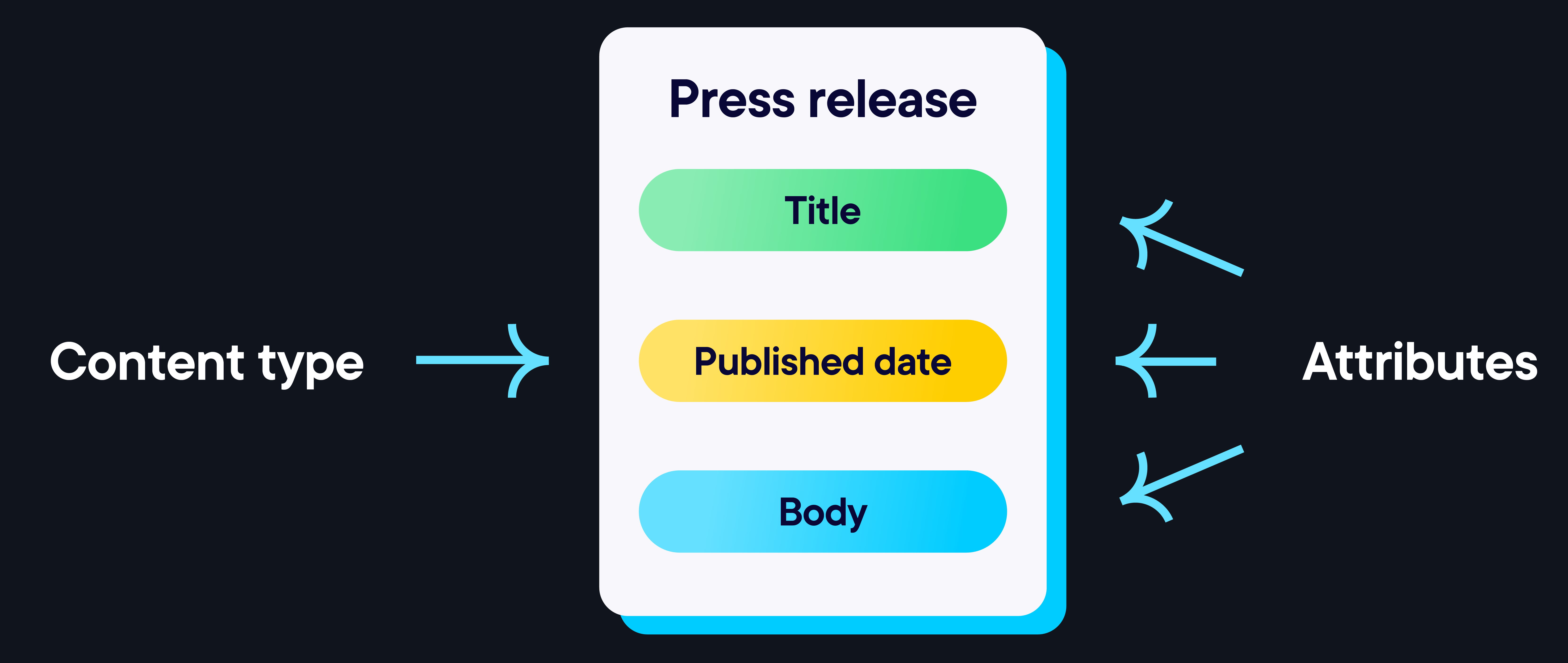Effiziente Verwaltung von Inhalten über eine Million und eine (okay, ich übertreibe vielleicht ein wenig...) Plattform hinweg. Es fühlt sich ein bisschen so an, als würden Sie auf einem Laufband laufen, das permanent auf "Laufen Sie um Ihr Leben" eingestellt ist. 😅😓
Hier kommt die Content-Modellierung ins Spiel - ein strategischer Weg, um Ihre Inhalte so zu strukturieren, dass sie leichter zu verwalten, zu skalieren und über so ziemlich jeden denkbaren Kanal wiederzuverwenden sind. Wenn wir Ihr Interesse geweckt haben, dann lesen Sie weiter.
Denn wir erklären Ihnen hier die Grundlagen der Inhaltsmodellierung, warum sie wichtig ist und wie sie sowohl für Vermarkter als auch für Entwickler von Nutzen sein kann. Und (weil wir so hilfsbereit sind) zeigen wir Ihnen auch, wie Sie Ihr Inhaltsmodell erstellen, welche Fallstricke Sie vermeiden sollten und welche Erfolgsmethoden Sie anwenden können, um sicherzustellen, dass Ihr Modell bei Bedarf skaliert werden kann. Außerdem gehen wir darauf ein, wie neue Technologien wie KI und Personalisierung die Modellierung von Inhalten noch leistungsfähiger machen können.
Am Ende dieses Leitfadens werden Sie eine klare Roadmap für die Implementierung eines Inhaltsmodells auf Ihrer eigenen Website haben. Schnappen Sie sich jetzt Ihr Lieblingsgetränk und machen Sie es sich gemütlich - lassen Sie uns mit der Modellierung von Inhalten beginnen.
Was zum Teufel ist Content Modeling (und warum sollte Sie das interessieren)?
Content Modeling klingt ein wenig geheimnisvoll und technisch, aber wir versprechen Ihnen, dass es das nicht ist. In seiner einfachsten Form ist Content Modeling der Prozess der Definition der Struktur Ihrer Inhalte, so dass diese leichter zu verwalten, zu bearbeiten und über verschiedene Plattformen hinweg wiederzuverwenden sind. Anstatt den gesamten Inhalt Ihrer Website als ein großes Durcheinander von Text, Bildern und Links zu betrachten, unterteilt ein Inhaltsmodell alles in wiederverwendbare, modulare Komponenten.
Es ist ein bisschen wie das Bauen mit Legosteinen (obwohl wir zugeben müssen, dass es nicht ganz so viel Spaß macht). Jedes Inhaltselement, ob Produktbeschreibung, Testimonial oder Blogtitel, hat seinen Platz und Sie können es einfach kombinieren, um verschiedene Arten von Inhalten zu erstellen.
Aber was ist das "Na und?" für uns Vermarkter, höre ich Sie sagen? Nun, wie wäre es damit: Ein Inhaltsmodell bedeutet, dass Sie nicht jedes Mal bei Null anfangen müssen, wenn Sie eine neue Kampagne starten wollen. Stattdessen können Sie auf Ihre praktische Bibliothek mit vorab genehmigten, markengerechten Inhaltsblöcken zurückgreifen, um im Handumdrehen ansprechende Erlebnisse zu schaffen. Ziemlich raffiniert, nicht wahr?
Warum Content Modeling Ihr Lebensretter im Marketing ist (nein, wirklich)
In der Omnichannel-Welt von heute hält sich Ihr Publikum nicht mehr nur auf Ihrer Website auf. Diese Leute sind überall - sie scrollen durch die sozialen Medien, öffnen E-Mails, sprechen mit Smart Devices und surfen in Mobile Apps. Wenn Sie für jede dieser Plattformen einzigartige Inhalte von Grund auf neu erstellen, dann brauchen Sie mehr als nur eine Tasse Kaffee, um mitzuhalten. 🏃♀️
Mit Content Modeling können Sie Inhalte verwalten und bereitstellen, die für alle diese Berührungspunkte optimiert sind. Und das, ohne dass sich Ihr Arbeitsaufwand verdoppelt - oder (Gott bewahre) verdreifacht -. Und, was ebenso wichtig ist, die Modellierung von Inhalten stellt sicher, dass Sie über alle Kanäle hinweg ein konsistentes Markenerlebnis bieten. Ganz gleich, ob Ihr Publikum auf Ihrer Site stöbert oder durch seinen Instagram-Feed scrollt, jeder Berührungspunkt ist perfekt auf den Ton, den Stil und die Botschaft Ihrer Marke abgestimmt.
Wie die Modellierung von Inhalten Ihren Verstand retten kann (und Ihnen Ihre Zeit zurückgibt)
Nachdem wir nun die Grundlagen behandelt haben, lassen Sie uns darüber sprechen, warum es sich lohnt, Content Modeling zu betreiben. Denn Content Modeling ist nicht nur ein schickes Modewort, Leute.
- Für Vermarkter: Die Modellierung von Inhalten bietet Schnelligkeit, Konsistenz und eine einfache Personalisierung. Anstatt das Rad ständig neu zu erfinden, können Sie Inhaltsblöcke wiederverwenden. Das bedeutet schnellere Kampagnenstarts und die Möglichkeit, Inhalte für verschiedene Zielgruppensegmente zu personalisieren, ohne dass Sie ins Schwitzen kommen (oder Ihr Gehirn anstrengen müssen).
- Für Entwickler: Ein gut strukturiertes Inhaltsmodell erleichtert Ihrem Entwicklungsteam die Verwaltung von Aktualisierungen und Inhaltsänderungen, ohne dass Sie jedes Mal umständlich fehlerhaften Code korrigieren müssen. Es bedeutet auch, dass die Skalierung Ihrer Website, das Hinzufügen neuer Inhaltstypen oder die Einführung neuer Funktionen nahtlos erfolgen kann, ohne dass eine komplette Überarbeitung der Site erforderlich ist. Der Nebeneffekt: Die Entwickler müssen viel weniger Zeit für Routine-Updates aufwenden und können ihre begrenzten Ressourcen besser für die Entwicklung von Funktionen nutzen, die einen echten Mehrwert bieten.
Die Grundlagen der Inhaltsmodellierung
Okay, Sie sind also von der Inhaltsmodellierung überzeugt. Aber wie genau funktioniert sie? Gut, dass Sie das fragen, denn wir werden es für Sie aufschlüsseln.
Inhaltstypen
Inhaltstypen sind die verschiedenen Formate, die Ihre Inhalte annehmen - wir sprechen von Blogs, Produktseiten, Fallstudien, Teambiografien und allem, was dazwischen liegt. Jede Art von Inhalt, die Ihre Marke erstellt, fällt unter einen bestimmten Inhaltstyp. Wenn Sie eine E-Commerce-Website betreiben, haben Sie vielleicht eine Menge Inhalte wie Produktseiten, Kundenrezensionen und Anleitungen. Wenn Sie für ein SaaS-Unternehmen arbeiten, erstellen Sie vielleicht Whitepapers, Blogbeiträge und Fallstudien. Jeder Inhaltstyp hat seine eigenen Anforderungen und Felder, aber sie folgen alle einer einheitlichen Struktur.
(Mal ehrlich... wie oft können wir das Wort "Inhalt" in einem Absatz verwenden. 🤦)
Felder
Felder stellen die einzelnen Informationen innerhalb eines bestimmten Inhaltstyps dar. Dabei kann es sich um Textfelder ("Überschrift" oder "Text"), Medienfelder ("Bild" oder "Video") oder sogar um speziellere Felder wie Daten oder Tags handeln. Klar definierte Felder helfen Ihnen, Ihre Inhalte zu organisieren und konsistent zu halten.
Beziehungen
Beziehungen sorgen dafür, dass Ihre Inhalte dynamisch und miteinander verknüpft sind. Eine Produktseite sollte zum Beispiel idealerweise mit verwandten Blogbeiträgen oder Kunden Cases verlinkt sein. Die Definition dieser Beziehungen sorgt für ein integriertes Erlebnis, bei dem Kunden nahtlos zwischen verwandten Inhalten navigieren können.
Die Idee dahinter ist, dass das CMS bei der Erstellung von Inhalten mit Hilfe Ihres Inhaltsmodells auf vordefinierte Inhaltstypen und -felder zurückgreifen kann, um sicherzustellen, dass sich alles dort befindet, wo es hingehört. In einem herkömmlichen CMS werden die Inhalte in der Regel als statische Seiten gespeichert, was ihre Wiederverwendung erschwert. Mit einem Inhaltsmodell hingegen ist jedes Inhaltsfeld unabhängig, was Ihnen viel mehr Flexibilität bei der Wiederverwendung und Neukombination von Inhalten auf verschiedenen Plattformen und Geräten bietet.
Wie Sie mit der Modellierung von Inhalten beginnen können
Nachdem wir uns nun mit den theoretischen Grundlagen beschäftigt haben, lassen Sie uns die Ärmel hochkrempeln und mit der praktischen Umsetzung beginnen.
-
Identifizieren Sie Ihre wichtigsten Inhalte
Überlegen Sie, welche Arten von Inhalten Ihre Marke regelmäßig produziert. Sind es Blogbeiträge, Produktbeschreibungen, Fallstudien? Beginnen Sie mit diesen.
-
Definieren Sie die Felder für jeden Inhaltstyp
Überlegen Sie für jeden Inhaltstyp, welche Felder Sie benötigen. Wenn Sie z.B. ein Inhaltsmodell für einen Blogbeitrag entwerfen, haben Sie Dinge wie Überschrift, Text, Autor und Veröffentlichungsdatum. Es ist jedoch nicht nötig, zu detailliert zu werden. Sie wollen genug Struktur, um die Konsistenz zu wahren, aber nicht so viel, dass Ihr Inhaltsmodell unhandlich wird.

Bildquelle: Optimizely -
Stellen Sie Beziehungen zwischen Ihren Inhaltstypen her
Entscheiden Sie, wie Ihre Inhaltstypen zueinander in Beziehung stehen. Sollen Blogbeiträge mit Autorenbiografien verlinkt werden? Sollten Produktseiten mit Kundenrezensionen verlinkt sein? Durch diese Beziehungen fühlen sich Ihre Inhalte nicht nur zusammenhängender an, sie sorgen auch für ein besseres Erlebnis für den Benutzer.
-
Übertragen Sie das Inhaltsmodell auf Ihr CMS
Ahhh, der beste Schritt von allen - der letzte Schritt! Hier geht es darum, Ihr Inhaltsmodell in Ihr CMS zu integrieren. Hier standardisieren Sie die Erstellung von Inhalten, verbessern die Effizienz Ihres Teams und stellen sicher, dass alle Ihre Inhalte in Ihre definierte Struktur passen. Sobald Ihr Inhaltsmodell eingerichtet ist, werden Sie sich fragen, wie Sie jemals ohne es ausgekommen sind.
Häufige Fehler bei der Modellierung von Inhalten (und wie Sie sie vermeiden können 🫸)
Bitte, wir flehen Sie an, tun Sie das nicht:
- Machen Sie Ihr Modell nicht zu kompliziert: Halten Sie es einfach. Versuchen Sie nicht, ein Modell zu erstellen, das jedes einzelne Szenario berücksichtigt, sonst haben Sie am Ende ein ziemliches Durcheinander, das eher hinderlich als hilfreich ist.
- Versäumen Sie es, (für die Zukunft) zu planen: Die Content-Strategie Ihrer Marke wird sich weiterentwickeln, also stellen Sie sicher, dass Ihr Modell flexibel genug ist, um sich anzupassen. Überlegen Sie, wie sich neue Kanäle wie die Sprachsuche oder eine Mobile App auf Ihr Content-Modell auswirken könnten.
- Ignorieren Sie kanalübergreifend: Denken Sie daran, dass Ihre Inhalte nicht nur auf Ihrer Website zu finden sein werden. Stellen Sie also sicher, dass Ihr Modell für eine kanalübergreifende Verbreitung ausgelegt ist, sei es per E-Mail, über soziale Medien oder die nächste Plattform.
TL; DR: Erfolgsmethoden für die Modellierung von Inhalten
- Halten Sie es einfach, aber skalierbar: Ein sauberes, einfaches Modell ist leichter zu pflegen und effizienter. Beginnen Sie klein, aber lassen Sie Raum für Wachstum. So stellen Sie sicher, dass Ihr Inhaltsmodell erweitert werden kann, wenn sich Ihre geschäftlichen Anforderungen ändern.
- Sorgen Sie für Konsistenz bei allen Inhaltstypen: Ein gut strukturiertes Modell stellt sicher, dass Ihre Inhalte auf allen Plattformen und an allen Kontaktpunkten einheitlich aussehen und wirken. Dies stärkt Ihre Marke und verbessert das Erlebnis für den Benutzer.
- Planen Sie Lokalisierung und Personalisierung: Wenn Ihre Marke weltweit tätig ist oder Inhalte für bestimmte Zielgruppen personalisiert, sollten Sie sicherstellen, dass Ihr Modell Unterschiede in Sprache, Region und Benutzerpräferenzen berücksichtigen kann.
Die Zukunft der Inhaltsmodellierung 🔮
Wenn wir versuchen abzuschätzen, wohin sich die Content-Modellierung entwickelt, stechen zwei wichtige Trends hervor: der Aufstieg von KI und Automatisierung und die steigende Nachfrage nach Personalisierung.
Seien wir ehrlich, wir stellen ziemlich hohe Anforderungen an unsere Marketingteams. Wir müssen personalisierte Erlebnisse in großem Umfang bereitstellen und gleichzeitig eine wachsende Zahl von Plattformen und Kanälen verwalten. An dieser Stelle wird die Zukunft der Content-Modellierung spannend - es geht um mehr als nur die Organisation von Inhalten, es geht um den Einsatz von Technik zur Steigerung von Effizienz, Kreativität und Erlebnis.
KI und Automatisierung
Die Zukunft ist da, und sie beinhaltet viel mehr KI, als wir uns wahrscheinlich noch vor ein paar Jahren vorstellen konnten. Stellen Sie sich vor, dass KI Ihnen hilft, Felder vorzuschlagen, Ihre Inhalte zu optimieren oder personalisierte Versionen für verschiedene Zielgruppensegmente zu erstellen. Ziemlich cool, oder?
Wenn KI in Ihr Inhaltsmodell eingebettet ist, könnte sie potenziell aus Ihren Daten lernen, Inhaltsempfehlungen für bestimmte Nutzersegmente feinabstimmen und sogar anpassen, wie und wo Inhalte auf der Grundlage des Nutzerverhaltens bereitgestellt werden. Die Integration von KI in Ihre Marketingstrategie kann diese Funktionen verbessern und für eine intelligentere Automatisierung und gezieltere Inhalte sorgen.
Die Automatisierung spielt auch bei der Skalierung der Content-Erstellung eine wichtige Rolle. So können KI-gestützte Tools zur Erstellung von Inhalten jetzt automatisch Produktbeschreibungen oder Blogbeiträge auf der Grundlage eines vordefinierten Inhaltsmodells generieren, so dass Sie sich auf strategischere Dinge konzentrieren können, anstatt Inhalte bis zum Gehtnichtmehr zu schreiben und umzuschreiben.
Personalisierung
Bei der Fülle von Inhalten, die um Ihre Aufmerksamkeit konkurrieren, erwarten Ihre Kunden, dass Marken digitale Erlebnisse liefern, die sie direkt ansprechen. Ein flexibles, gut strukturiertes Inhaltsmodell ist der Schlüssel zur Bereitstellung der richtigen Inhalte für die richtige Zielgruppe zur richtigen Zeit über so ziemlich jeden beliebigen Kanal.
Ganz gleich, ob es darum geht, die Botschaften für verschiedene Zielgruppen anzupassen oder regionalspezifische Inhalte in mehreren Sprachen bereitzustellen, ein gut durchdachtes Content-Modell macht personalisiertes Marketing im großen Stil erst möglich. Die Entwicklung einer Personalisierungsstrategie kann diese Bemühungen noch verstärken und dafür sorgen, dass sich jeder Nutzer einzigartig angesprochen fühlt.
Und die Zukunft? Nun, sie wird nur noch heller werden, wenn KI und Personalisierung zusammenarbeiten, um Erlebnisse zu schaffen, die hyper-targeting, reaktionsschnell und - seien wir ehrlich - irgendwie atemberaubend sind.
Auf die Plätze, fertig, modellieren
Die Modellierung von Inhalten mag einschüchternd klingen, aber das muss es nicht. Fangen Sie klein an, erstellen Sie ein Modell, das Ihren Bedürfnissen entspricht, und beobachten Sie, wie Ihre Inhalte besser organisiert und effizienter werden und für alle Herausforderungen gerüstet sind, die sich ihnen in den Weg stellen.
- Zuletzt geändert: 06.02.2025 17:44:16


